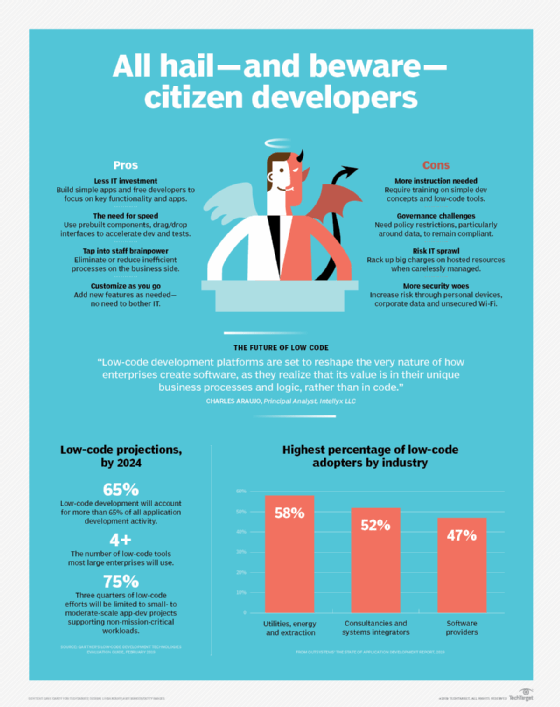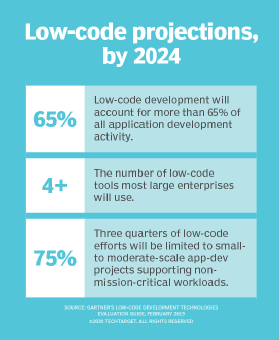
Nomad_Soul - Fotolia
Examining the low-code market's race for citizen developers
Low-code and no-code vendors are fighting viciously for the favor of citizen developers. Examine the reasons for this trend and the market moves that reveal these vendors' motives.
With the need for rapid app development, deployment and maintenance, the low-code market has grown significantly. By 2023, over 50% of medium to large enterprises will have adopted a low-code application platform as one of their strategic application platforms, according to market analysis from Gartner, a research and advisory firm.
Alongside the emergence of low-code platforms, the market saw an increased demand for products that feature "no-code" development. While these applications operate on blocks of code that exist in the back end, the code is managed by a provider and hidden from the user.
According to Jason Wong, vice president and analyst at Gartner, the goal is to enable application configuration through vendor-provided building blocks without requiring the user to understand how to read or write code. These platforms typically include options for custom scripting, which provides a notable amount of extensibility for enterprise users.
The rise of citizen developers
A major part of no-code's popularity revolves around the visual drag-and-drop or point-and-click interfaces. These types of interfaces enable non-tech business personnel -- or citizen developers -- to create their own apps without having extensive coding knowledge.
While low-code is good news for business-level users, Wong pointed out that enterprise-level developers are likely not as excited. There are a few reasons for this, one of which being that these developers may feel their job is threatened by what they perceive as businesses looking to cut them out of the app development process.
 Jason Wong
Jason Wong
"These developers are professionals -- they spent a lot of money to get their degrees and a lot of time learning language and the tools," Wong said. "Now [enterprises] come along and say, 'Oh, don't worry about that … just drag and drop, point and click, and then you build an app.'"
Additionally, developers worry that citizen developers are not likely to pay mind to critical aspects of application development. For example, many enterprise software systems have specific security requirements to protect customer data and intellectual property.
To ensure compliance, professional developers put in the work to know what the application runs on, where the data travels and what kind of exposure there is. The worry, Wong said, is that business-level users either don't care or think enough about issues like application security, as they are potentially narrowing their focus on the application capabilities they want.

Notable low-code market moves in 2020
The growing enterprise interest in low-code platforms has caused vendors, including AWS and Google, to strengthen their app development portfolio. Review some of the top vendor acquisitions and notable product releases in the no-code and low-code market in 2020.
January 2020: Google acquires AppSheet
Last January, Google acquired AppSheet to strengthen its focus on low-code app development. AppSheet ingests data from various sources, such as Excel and Google Sheets, then empowers users to develop workflows with the form-based interface.
Rather than purchase core enterprise applications, such as ERP and CRM, Google is apparently targeting nontraditional coders. This AppSheet acquisition also represents a counterstrike against Microsoft's low-code app development platform, Power Apps, which has gained appeal among citizen developers.
June 2020: Amazon releases Honeycode
Amazon Honeycode, announced this past June, is a fully managed mobile and web application development tool that the vendor describes as a true no-code platform. While some experts see Amazon as late to the game (compared to Microsoft and Google), Amazon Honeycode's goal is to enable business users to create apps through spreadsheets.

Typically, low-code and no-code tools present users a visual workflow or UX interface to build applications. Honeycode, on the other hand, uses the spreadsheet interface to provide non-coders the ability to create applications using, for example, Excel formulas they are already proficient and comfortable in.
July 2020: Deloitte and Unqork join forces
This past July, Unqork, a no-code platform provider, partnered with the financial consulting firm Deloitte in an effort to create a platform for citizen development targeted toward specific industry verticals. Deloitte, which has a history of extensive industry consultation experience, hopes to deliver customized versions of Unqork's visually based no-code platform for citizen developers in specific verticals, such as insurance, banking, healthcare and the public sector.
September 2020: Mendix releases new platform version
Mendix, a low-code application development platform provider, released an updated version of its flagship product this past September called Mendix 9 (MX9). One celebrated addition to MX9 is the Mendix Data Hub, which pulls important business and application data into a centralized, searchable catalog that developers can use to build apps quickly.
To support AI capabilities, the company also released Mendix Performance Assist, a bot that automatically suggests or implements changes to applications when it determines it will speed up development time or create a better application.







